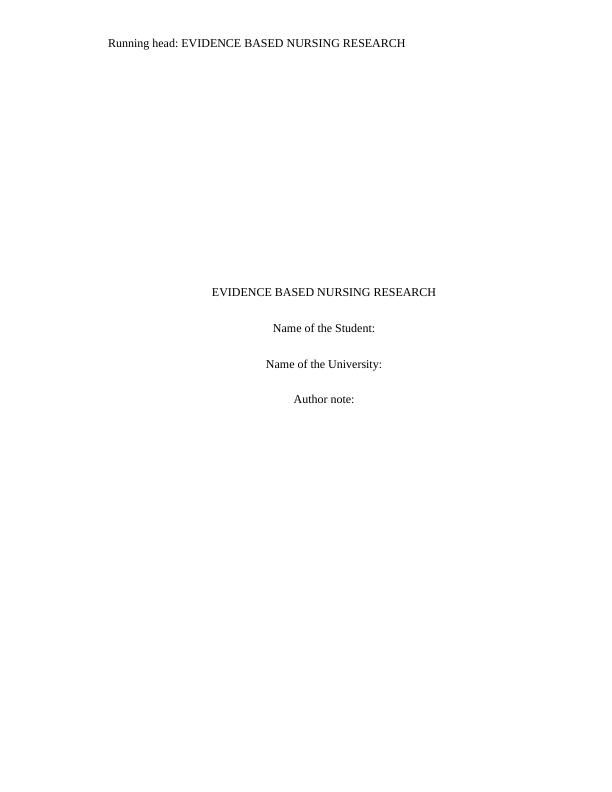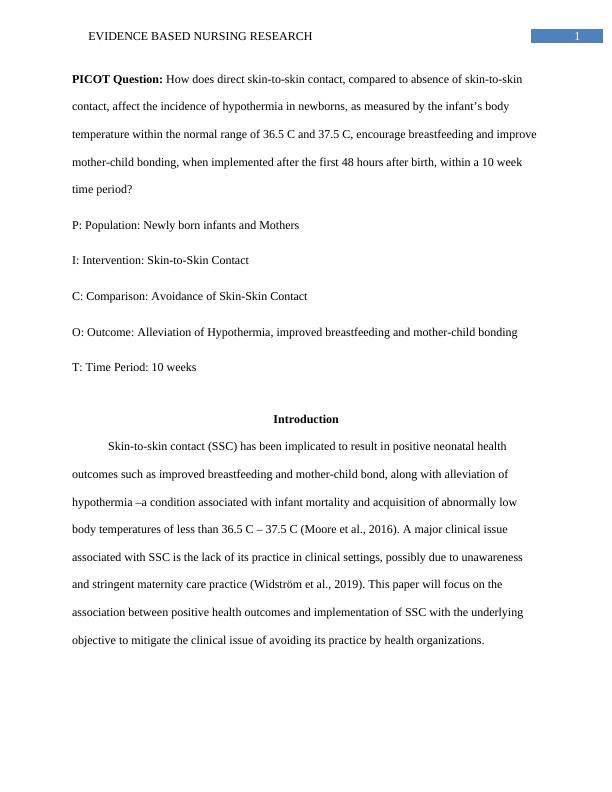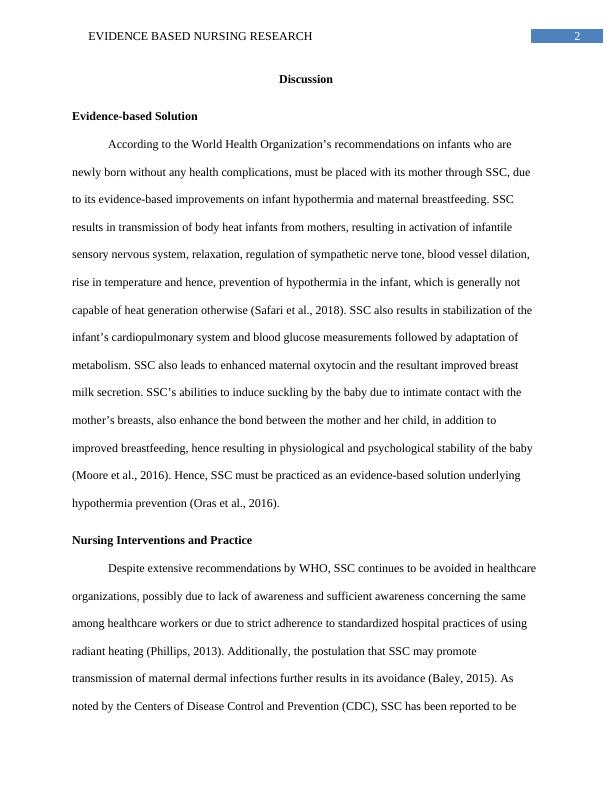Evidence Based Nursing Research
Added on 2023-04-21
8 Pages2168 Words158 Views
Running head: EVIDENCE BASED NURSING RESEARCH
EVIDENCE BASED NURSING RESEARCH
Name of the Student:
Name of the University:
Author note:
EVIDENCE BASED NURSING RESEARCH
Name of the Student:
Name of the University:
Author note:

1EVIDENCE BASED NURSING RESEARCH
PICOT Question: How does direct skin-to-skin contact, compared to absence of skin-to-skin
contact, affect the incidence of hypothermia in newborns, as measured by the infant’s body
temperature within the normal range of 36.5 C and 37.5 C, encourage breastfeeding and improve
mother-child bonding, when implemented after the first 48 hours after birth, within a 10 week
time period?
P: Population: Newly born infants and Mothers
I: Intervention: Skin-to-Skin Contact
C: Comparison: Avoidance of Skin-Skin Contact
O: Outcome: Alleviation of Hypothermia, improved breastfeeding and mother-child bonding
T: Time Period: 10 weeks
Introduction
Skin-to-skin contact (SSC) has been implicated to result in positive neonatal health
outcomes such as improved breastfeeding and mother-child bond, along with alleviation of
hypothermia –a condition associated with infant mortality and acquisition of abnormally low
body temperatures of less than 36.5 C – 37.5 C (Moore et al., 2016). A major clinical issue
associated with SSC is the lack of its practice in clinical settings, possibly due to unawareness
and stringent maternity care practice (Widström et al., 2019). This paper will focus on the
association between positive health outcomes and implementation of SSC with the underlying
objective to mitigate the clinical issue of avoiding its practice by health organizations.
PICOT Question: How does direct skin-to-skin contact, compared to absence of skin-to-skin
contact, affect the incidence of hypothermia in newborns, as measured by the infant’s body
temperature within the normal range of 36.5 C and 37.5 C, encourage breastfeeding and improve
mother-child bonding, when implemented after the first 48 hours after birth, within a 10 week
time period?
P: Population: Newly born infants and Mothers
I: Intervention: Skin-to-Skin Contact
C: Comparison: Avoidance of Skin-Skin Contact
O: Outcome: Alleviation of Hypothermia, improved breastfeeding and mother-child bonding
T: Time Period: 10 weeks
Introduction
Skin-to-skin contact (SSC) has been implicated to result in positive neonatal health
outcomes such as improved breastfeeding and mother-child bond, along with alleviation of
hypothermia –a condition associated with infant mortality and acquisition of abnormally low
body temperatures of less than 36.5 C – 37.5 C (Moore et al., 2016). A major clinical issue
associated with SSC is the lack of its practice in clinical settings, possibly due to unawareness
and stringent maternity care practice (Widström et al., 2019). This paper will focus on the
association between positive health outcomes and implementation of SSC with the underlying
objective to mitigate the clinical issue of avoiding its practice by health organizations.

2EVIDENCE BASED NURSING RESEARCH
Discussion
Evidence-based Solution
According to the World Health Organization’s recommendations on infants who are
newly born without any health complications, must be placed with its mother through SSC, due
to its evidence-based improvements on infant hypothermia and maternal breastfeeding. SSC
results in transmission of body heat infants from mothers, resulting in activation of infantile
sensory nervous system, relaxation, regulation of sympathetic nerve tone, blood vessel dilation,
rise in temperature and hence, prevention of hypothermia in the infant, which is generally not
capable of heat generation otherwise (Safari et al., 2018). SSC also results in stabilization of the
infant’s cardiopulmonary system and blood glucose measurements followed by adaptation of
metabolism. SSC also leads to enhanced maternal oxytocin and the resultant improved breast
milk secretion. SSC’s abilities to induce suckling by the baby due to intimate contact with the
mother’s breasts, also enhance the bond between the mother and her child, in addition to
improved breastfeeding, hence resulting in physiological and psychological stability of the baby
(Moore et al., 2016). Hence, SSC must be practiced as an evidence-based solution underlying
hypothermia prevention (Oras et al., 2016).
Nursing Interventions and Practice
Despite extensive recommendations by WHO, SSC continues to be avoided in healthcare
organizations, possibly due to lack of awareness and sufficient awareness concerning the same
among healthcare workers or due to strict adherence to standardized hospital practices of using
radiant heating (Phillips, 2013). Additionally, the postulation that SSC may promote
transmission of maternal dermal infections further results in its avoidance (Baley, 2015). As
noted by the Centers of Disease Control and Prevention (CDC), SSC has been reported to be
Discussion
Evidence-based Solution
According to the World Health Organization’s recommendations on infants who are
newly born without any health complications, must be placed with its mother through SSC, due
to its evidence-based improvements on infant hypothermia and maternal breastfeeding. SSC
results in transmission of body heat infants from mothers, resulting in activation of infantile
sensory nervous system, relaxation, regulation of sympathetic nerve tone, blood vessel dilation,
rise in temperature and hence, prevention of hypothermia in the infant, which is generally not
capable of heat generation otherwise (Safari et al., 2018). SSC also results in stabilization of the
infant’s cardiopulmonary system and blood glucose measurements followed by adaptation of
metabolism. SSC also leads to enhanced maternal oxytocin and the resultant improved breast
milk secretion. SSC’s abilities to induce suckling by the baby due to intimate contact with the
mother’s breasts, also enhance the bond between the mother and her child, in addition to
improved breastfeeding, hence resulting in physiological and psychological stability of the baby
(Moore et al., 2016). Hence, SSC must be practiced as an evidence-based solution underlying
hypothermia prevention (Oras et al., 2016).
Nursing Interventions and Practice
Despite extensive recommendations by WHO, SSC continues to be avoided in healthcare
organizations, possibly due to lack of awareness and sufficient awareness concerning the same
among healthcare workers or due to strict adherence to standardized hospital practices of using
radiant heating (Phillips, 2013). Additionally, the postulation that SSC may promote
transmission of maternal dermal infections further results in its avoidance (Baley, 2015). As
noted by the Centers of Disease Control and Prevention (CDC), SSC has been reported to be

End of preview
Want to access all the pages? Upload your documents or become a member.
Related Documents
Skin-to-Skin Contact and Hypothermia in Newborns: A Literature Reviewlg...
|7
|1855
|350
Qualitative Research Critique and Ethical Considerationslg...
|6
|1376
|260
Impacts of Skin to Skin Contactlg...
|17
|4256
|48
Research Critique & PICOT Statement - Final Draftlg...
|10
|2719
|405
EVIDENCE BASED NURSING RESEARCH Nursing: Evidence Based Nursing Researchlg...
|3
|473
|270
Skin-to-Skin Contact between a mother and her new-bornlg...
|3
|465
|495
